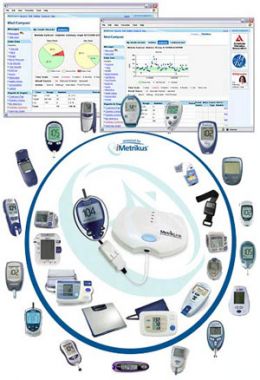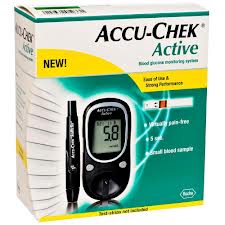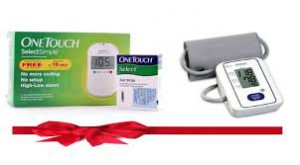If you have diabetes, one needs a blood glucose meter — a small device — to measure, store and display the blood glucose level. Glucometer is commonly used in emergency rooms in hospitals, ambulatory medical care services as in ambulances, helicopters or sea transport while shifting patients. The glucometer is used for analysing sugar leels and adjust dose medication with the help of the health care professional or diabetes educator. This is not used in the diagnosis of Diabetes.
Exercise, food, medications, stress and other factors affect the blood glucose level. Using a blood glucose meter can help better manage the diabetes by tracking any fluctuations caused by these factors.
Many types of blood glucose meters are available, from basic models to more-advanced meters with multiple features and options. The cost of blood glucose meters and test strips varies. Study all the options before deciding which model to buy.. As with any electronic device, this cannot be immersed in water, should not be stored in extremes of temperature and humidity which can affect the device or even the test strips. Most of the new model glucometer devices have an in built check that does not display readings at extremes of temperature. Using a glucometer at high altitude as when climbing high mountains can give erratic readings.
The glucometer uses an enzymatic portion on a test strip which is in a dehydrated state when packed and a detector. The glucose in the blood sample reacts with the enzyme to produce the level which is detected. The commonly used enzymes are hexokinase, glucose oxidase and glucose dehydrogenase
Basics while using any glucometer
- Check the expiration date of the kit
- Make sure the lancets, glucometer, test strips are available globally.
- Make sure the warranty card is filled out and handed over.
- Ask for a demonstration if need be.
- Some meters need a code chip to be inserted with each new box of test strips.
- Always clean the finger tip before pricking the finger tip for the sample of blood. The sides of the non dominant hand are used as the skin is thinner at the side of the fingertips.
- The blood should be flowing well. Do not squeeze the finger tip excessively to get the blood out- this affects the reading.
- Do not reuse the lancets or test strips.
- Dispose the lancets in a sharps disposal bin.
- Remember to use the glucometer often, say at least twice a week. If not used regularly, it may cause the batteries to wear off by discharging or the IC to burn off. It is similar to a motor car that is not used for a month or two. The battery will not work at that time.
- Get the glucometer calibrated often as well as periodic testing of the control solution is necessary. Some of the newer machines are auto calibrating.
Choosing the right meter
When selecting a blood glucose meter, it can help to know the basics of how they work.
- To use most blood glucose meters, first insert one end of a test strip into the device.
- Then, prick a clean fingertip with a special needle (lancet) to get a drop of blood.
- Wipe away the first drop of blood.
- Carefully touch the other end of the test strip to the drop of blood and wait for a blood glucose reading to appear on the screen. There are meters which can determine the blood glucose and blood ketone levels as well. These meters are useful for type 1 diabetic patients. It is marketed by the Freestyle under the name Freestyle Optium Xceed.
Blood glucose meters are usually accurate in how they measure glucose, but they differ in the type and number of features they offer. There is a difference between the values obtained by the glucometer and the blood test done at the hospital. The glucometer checks the capillary glucose level. The hospital or clinic estimates the glucose from a sample drawn from the vein.
Here are several factors to consider when choosing a blood glucose meter:
• Cost. Meters vary in price, so shop around. Be sure to factor in the cost of test strips as the insurance doesn’t pay for them. Test strips are the most expensive part of monitoring because they’re used so often. A meter may be the cheapest one on the market, but may not be a good deal if the strips cost twice as much. Also, individually packaged strips tend to cost more, but you might not use all the strips in a container before the expiration date or within the required number of days after opening the container. Figure out which type of strip is most cost-effective for you. Remember that the strips have expiration dates on the cover. Please check it out.
• Ease of use and maintenance. Some meters are easier to use than others. Are both the meter and test strips comfortable to hold? Can you easily see the numbers on the screen? How easy is it to get blood onto the strips? Does it require a small or large drop of blood?
- Also, some brands of meters need to be coded and others have no coding. Code numbers are used to calibrate your meter with the test strips for accurate results. Make sure the strips can be bought from other parts of the world as well so that travel does not be cumbersome.
• Special features. Ask about the features to see what meets your specific needs. For example, some meters are large with strips that are easier to handle. Some are compact and easier to carry. People with impaired vision can buy a meter with a large screen . Colorful meters that give a quick reading are available for children. Some models, such as Easy Max Lite® have a backlight, which is handy for nighttime readings. For those with impaired hearing, models such as Easy Max Voice®, Advocate Redi-Code®, Fora®,Prodigy® and Element Plus® are useful. Others are manufactured to withstand extreme temperatures, which may be useful for people who spend a lot of time outdoors, such as hikers or construction workers.
• Information storage and retrieval. Consider how the meter stores and retrieves information. Some can track all the information one would normally write in a log, such as the time and date of a test, the result, and trends over time. Some meters offer the ability to download your blood glucose readings to a computer or your cell phone and then email the test results to your doctor.
• Support. Many meter manufacturers include a toll-free number on the back of the meter or packing. Look for a meter that includes clear instructions that demonstrate the correct way to use the meter. Some manufacturers offer user manuals on their websites.
Alternative site monitor Allows blood samples from areas likely to be less painful than your finger, such as your arm, abdomen or thigh. These are not as accurate as fingertip samples when blood sugar level is rising or falling quickly.
Continuous glucose testing Uses a sensor placed under skin to measure blood sugar level; transmits each reading to a small recording device worn on your body; sounds an alarm if blood sugar level becomes too low or too high Expensive; requires sensor to be replaced every three to seven days depending on the brand; must check blood sugar level with a traditional monitor when dosing for insulin or treating low blood sugar to confirm readings
• Infrared, laser light and electric current technologies are among a few of the possible offerings on the horizon for noninvasive methods of checking blood sugar levels. But, these may cause irritation to the skin where it is placed upon.
Consider these factors that affect meter accuracy and the steps to resolve or prevent the problem:
- Test strip problems —Throw out damaged or outdated test strips. Store strips in their sealed container; keep them away from heat, moisture and humidity. Be sure the strips are meant for your specific glucose meter.
- Extremes of temperature —Keep your glucose meter and test strips at room temperature.
- Alcohol, dirt or other substances on your skin— Wash your hands and the testing site with soap and water before pricking your skin.
- Improper coding— Some meters must be coded to each container of test strips. Be sure the code number in the device matches the code number on the test strip container.
- Monitor problems —Fully insert the test strip into the monitor. Replace the monitor batteries as needed.
- Not enough blood applied to the test strip —Apply a generous drop of blood to the test strip. Don’t add more blood to the test strip after the first drop is applied. Some meters do not need a large drop.
- Testing site location — Blood samples from alternate sites are not as accurate as fingertip samples when the blood sugar level is rising or falling quickly.
Blood glucose monitor quality control tests
When starting a new container of test strips, occasionally perform these quality control tests before using them and when the results seem unusual.
To perform a quality control test, do one or both of the following:
• Test using a control solution. Follow normal blood-testing procedure, but use a liquid control solution instead of blood. These solutions usually come with the monitor and are available at most drugstores and pharmacies. Follow package directions.
• Match the reading with lab results. Take the blood glucose monitor along when visiting the doctor or have an appointment for lab work. Check the blood glucose with the meter at the same time that blood is drawn for lab tests. Then compare the meter’s reading with the lab results. The meter’s result is considered accurate if it falls within 15 percent of the lab test result.

















